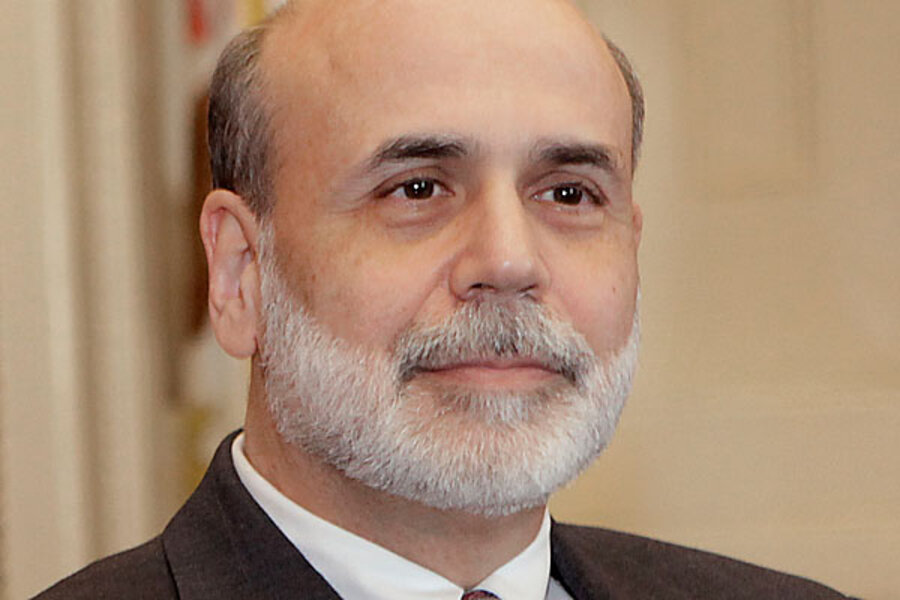Bernanke outlines 'exit' plan to extract Fed from safety net role
The Fed is on the case. That's the message Ben Bernanke is trying to send regarding the Federal Reserve's ability to craft a successful "exit strategy" from its own emergency economic-support programs.
A snowstorm canceled a congressional hearing where Mr. Bernanke was set to appear Wednesday, but it didn't stop the Fed chairman from pushing the "send" button to publish his prepared remarks.
"At some point the Federal Reserve will need to tighten financial conditions," he warned, following extraordinary infusions of monetary support that the central bank has orchestrated since the severe financial crisis of 2008.
The need for an exit strategy has been a hot topic on Wall Street for months. The Fed must walk a fine line, shifting monetary policy forcefully enough to prevent a potential pickup in inflation while also being cautious not to withdraw monetary ease before the economy is able to grow on its own.
Bernanke sought to downplay investor concerns that the Fed won't find it easy to manage this process. He said the Fed has been "developing the tools we will need to remove policy accommodation, and we are fully confident that at the appropriate time we will be able to do so effectively."
The Fed's many tools of intervention
When the financial crisis hit, the Fed did a lot more than just cut interest rates. It also created new avenues to funnel credit to banks, and devised new debt-buying programs to support markets for mortgage loans and corporate loans. All this was intended to ensure that credit markets would unfreeze, and it worked. Where it has been easy, the Fed has already exited from some of these programs.
In his prepared statement, Bernanke outlined several tools the Fed may begin to use later this year:
• The Fed can boost the interest it pays to commercial banks on the reserves they hold at the Fed. Banks will be reluctant to lend to others at a rate lower than what they can earn with the Fed, so this tool is a way for the Fed to push up all short-term interest rates.
• Using its more traditional post-recession practice, the Fed can also raise the interest rate it sets for overnight loans between commercial banks. But because of a buildup of "excess reserves" by banks during the crisis, the Fed appears poised to begin by focusing rate hikes on reserves. Later, Bernanke said, the Fed will be able to "return to an operating framework" centered around the so-called federal funds rate. (The Fed now pays 0.25 percent on excess reserves, and has set the federal funds rate at essentially zero.)
• Another important step could be to reduce the quantity of bank reserves, in effect trimming the supply of funds available in money markets. Bernanke outlined two approaches: converting bank reserves into instuments analogous to certificates of deposits, or entering into "reverse repurchase" agreements with private counterparties. The key detail, in either case, is that it would crimp the potential fuel for inflation. "Reverse repos and the deposit facility would together allow the Federal Reserve to drain hundreds of billions of dollars of reserves from the banking system quite quickly, should it choose to do so," Bernanke said.
• Bernanke said the Fed is also considering a boost in the "discount rate" on Fed loans to banks. This largely symbolic move would represent a step toward restoring a normal Fed monetary stance.
Economy still not normal
The announcement comes at a delicate time. Policymakers are under pressure to show they can back away from bailout practices of the past two years. But with unemployment at 9.7 percent, the economy is not yet back to normal.
The Fed chairman took care not to roil markets. Bernanke said the Fed will not start dumping the securities it has purchased since 2008 into the bond market.
"To help reduce the size of our balance sheet and the quantity of reserves, we are allowing agency [mortgage-backed securities] to run off as they mature or are prepaid," Bernanke said. If the Fed at some point pursues outright bond sales, he added that it would be gradual, "would be clearly communicated to market participants, and would entail appropriate consideration of economic conditions."
----
Follow us on Twitter.





